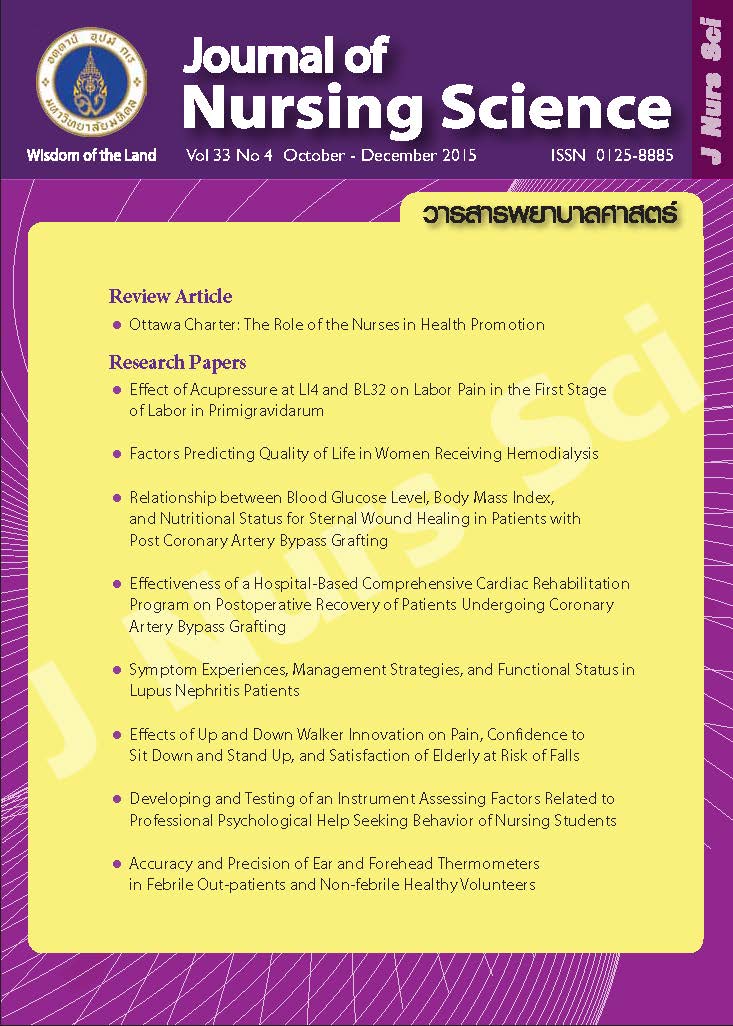Relationship between Blood Glucose Level, Body Mass Index, and Nutritional Status for Sternal Wound Healing in Patients with Post Coronary Artery Bypass Grafting
Main Article Content
Abstract
Purpose: To describe sternal wound healing and to study the relationships between postoperative blood glucose level, preoperative body mass index, and nutritional status for sternal wound healing in patients with post coronary artery bypass grafting (CABG).
Design: Descriptive correlational study.
Methods: The sample included 88 patients aged 18 or older who underwent CABG surgery at the cardiac surgical ward of two super tertiary hospitals in Bangkok. Data were collected using demographic characteristics form, the Blood glucose record form, the Body Mass Index (BMI), the Nutritional Risk Index (NRI), and the Wound Assessment Inventory (WAI). Data were analyzed using descriptive statistics and Pearson Product Moment Correlation Coefficient.
Main findings: Blood glucose at day 1-3 post CABG was at a high level, the mean blood glucose level was 192, 190, and 191 mg/dl, respectively. The mean body mass index was at a high level (mean = 25.05, SD = 4.65). Most body mass index was measured at Obese 1 (BMI 30.0-34.9). The mean nutritional status was at a high level (mean = 109.24, SD = 12.3). Most patients were not malnourished. Furthermore, the mean scores for sternal wound healing post-op Day 2-3 and Day 5-6 was at a low level (mean = 1.1, 1.02, SD = .48, .51). The results showed that the majority of patients experienced good wound healing. The maximum postoperative blood glucose level on Day 2 was positively correlated with delay sternal wound healing post-op Day 5-6 (r = .22, p < .05), the maximum postoperative blood glucose level on Day 3 was positively correlated with delay sternal wound healing post-op Day 2-3 and Day 5-6 (r = .24, r = .21, p < .05) while preoperative body mass index was positively correlated with delay sternal wound healing post-op Day 2-3 and Day 5-6. (r = .23, p < .05; r = .34, p < .01).
Conclusion and recommendations: The findings of this study indicate that nurses should be aware of patients with high blood glucose levels and obesity. Furthermore, nurses should monitor nutritional status and evaluate sternal wound healing in patients who undergo CABG surgery by using assessment tools in order to prevent and minimize the risk for sternal wound infection.
ความสัมพันธ์ระหว่างระดับน้ำตาลในเลือดหลังการผ่าตัดดัชนีมวลกาย และภาวะโภชนาการ ต่อการหายของแผลบริเวณสันอก ในผู้ป่วยหลังผ่าตัดทำทางเบี่ยงหลอดเลือดหัวใจ
บทคัดย่อ
วัตถุประสงค์: เพื่ออธิบายลักษณะการหายของแผลผ่าตัดบรเิวณสันอก และศึกษาความสัมพันธ์ระหว่างระดับนํ้าตาลในเลือดหลังการผ่าตัด ดัชนีมวลกาย และภาวะโภชนาการก่อนการผ่าตัดต่อการหายของแผลบริเวณสันอก ในผู้ป่วยหลังผ่าตัดทำทางเบี่ยงหลอดเลือดหัวใจ
รูปแบบการวิจัย: การศึกษาความสัมพันธ์เชิงบรรยาย
วิธีดำเนินการวิจัย: กลุ่มตัวอย่างเป็นผู้ป่วยที่ได้รับการผ่าตัดทำทางเบี่ยงหลอดเลือดหัวใจ อายุตั้งแต่ 18 ปีขึ้นไป จำนวน 88 คน ที่มารับการรักษาในโรงพยาบาลมหาวิทยาลัย 2 แห่งในกรุงเทพมหานคร เครื่องมือที่ใช้ในการวิจัยได้แก่ 1) แบบบันทึกข้อมูลส่วนบุคคล 2) แบบบัยทึกผลการตรวจระดับน้ำตาลในเลือดหลังการผ่าตัด 3) แบบบันทึกน้ำหนักและวัดส่วนสูง ของผู้ป่วยก่อนการผ่าตัด 4) แบบประเมินภาวะโภชนาการ 5) แบบประเมินการหายของแผล วิเคราะห์ข้อมูลด้วยสถิติเชิงพรรณนา และวิเคราะห์ความสัมพันธ์โดยใช้ค่าสัมประสิทธิ์สหสัมพันธ์เพียร์สัน
ผลการิจัย: หลังการผ่าตัดวันที่ 1-3 ผู้ป่วยมีระดับน้ำตาลในเลือดเฉลี่ยอยู่ในระดับสูง 192, 190 และ 191 mg/dl ตามลำดับ ค่าเฉลี่ยดัชนีมวลกายอยู่ในระดับสูง (mean = 25.05, SD = 4.65) ส่วนใหญ่มีภาวะโรคอ้วน ระดับ 1 (BMI 30.0-34.9) ค่าเฉลี่ยภาวะโภชนาการอยู่ในระดับสูง (mean = 109.24, SD = 12.3) ส่วนใหญ่ไม่มีภาวะทพุโภชนาการ ค่าเฉลี่ยคะแนนการหายของแผลผ่าตัดบริเวณสันอก วันที่ 2-3 และวันที่ 5-6 หลังการผ่าตัดอยู่ในระดับต่ำ (mean = 1.1, 1.02, SD = .48, .51) ส่วนใหญ่มีการหายของแผลที่ดีระดับน้ำตาลในเลือดที่สูงสุดหลังการผ่าตัดวันที่ 2 มีความสัมพันธ์เชิงบวกกับการหายช้าของแผลบริเวณสันอกวันที่ 5-6 หลังการผ่าตัด (r = .22, p < .05) ระดับน้ำตาลในดลือดสูงสุดหลังการผ่าตัดวันที่ 3 มีความสัมพันธ์เชิงบวกกับการหายช้าของแผลบริเวณสันอกในวันที่ 2-3 และวันที่ 5-6 หลังการผ่าตัด (r = .24, r = .21, p < .05) ดัชนีมวลกายก่อนนการผ่าตัดมีความสัมพันธ์เชิงบวก กับการหายช้าของแผลบรเิวณสันอกในวันที่ 2-3 และวันที่ 5-6 หลังการผ่าตัด (r = .23, p < .05, r = .34, p < .01)
สรุปและข้อเสนอแนะ: พยาบาลควรเฝ้าระวังและติดตามเป็นพิเศษในผู้ป่วยที่มีระดับนํ้าตาลในเลือดสูงและภาวะอ้วน โดยใช้ครื่องมือประเมินการหายของแผลบรเิวณสันอกในผู้ป่วยที่เข้ารับการผ่าตัดทำทางเบี่ยงหลอดเลือดหัวใจ เพื่อป้องกันและลดความเสี่ยงต่อการติดเชื้อแผลผ่าตัดบริเวณสันอก
คำสำคัญ: การผ่าตัดทำทางเบี่ยงหลอดเลือดหัวใจ การหายของแผล ดัชนีมวลกาย ภาวะโภชนาการ
Article Details
Copyright Notice: Nursing Science Journal of Thailand has exclusive rights to publish and distribute the manuscript and all contents therein. Without the journal’s permission, the dissemination of the manuscript in another journal or online, and the reproduction of the manuscript for non-educational purpose are prohibited.

Disclaimer: The opinion expressed and figures provided in this journal, NSJT, are the sole responsibility of the authors. The editorial board bears no responsibility in this regard.


